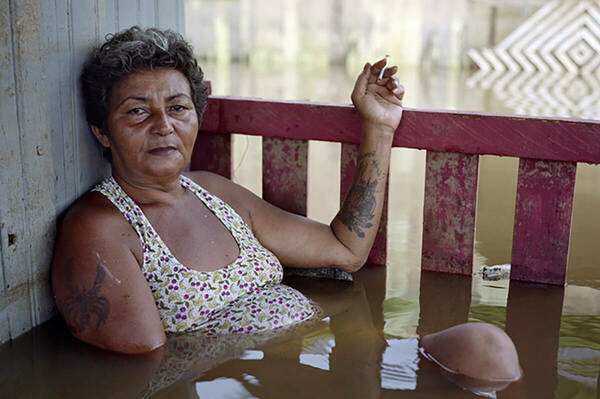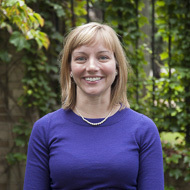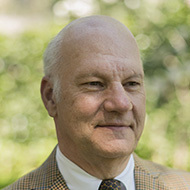
You know what they say about a picture’s worth.
In a year when the conversation across campus centered on sustainability — thanks to the 2021-22 Notre Dame Forum’s theme, “Care for Our Common Home: Just Transition to a Sustainable Future” — a photograph on display at the Snite Museum of Art spoke in a powerful way to what is at stake in the climate crisis debate.
The photograph is a portrait of a Brazilian woman resting, cigarette in hand, nearly chest-deep in water on what looks to be a porch. The woman looks blasé, like this circumstance is her normal. The photo is by photographer Gideon Mendel and is part of his series “Drowning World: Submerged Portraits.”

The photograph was selected for acquisition by students in the Snite Museum’s PhotoFutures collaborative collecting group, which is tasked each year with choosing a piece of contemporary photography related to a current issue to add to the museum’s permanent collection. The group’s theme this year, “Water and the Global Environmental Crisis,” was selected to complement the ND Forum theme.
PhotoFutures is open to students in any major. This academic year, eight students, including a graduate student and an Inspired Leadership Initiative fellow, met in the fall to hear from faculty on the water crisis and discuss the merits of the photographs presented as acquisition options by Bridget Hoyt, the museum’s curator of education for academic programs, and David Acton, the curator of photographs.

“Our collection is used for teaching, and this is an opportunity for them to determine what students 10 years, 25 years, 50 years from now might look at when they visit the museum,” Hoyt explained.
Senior political science and visual communication design double major Claire Stein has been involved in PhotoFutures for two years. She said this opportunity has helped her understand how art can illuminate world events and politics.
“I so appreciated the chance to build community and participate in lively debates with art lovers of various ages and expertise levels over the course of the semester,” she said. “Most of all, I’m proud to be associated with such an important piece, now a permanent part of the Snite Museum’s already fantastic collection.”
As someone deeply concerned about climate issues, Stein hopes campus conversations about what can often become a politicized topic can acknowledge scientific facts and the urgency of the issue — an urgency highlighted in images like this year’s PhotoFutures selection.
“At the same time, I would encourage participants in such conversations not to despair,” she said. “Humanity has persevered through many challenges we once believed to be insurmountable. Even if climate change forces humanity to adapt, I believe that we will somehow overcome the Armageddon of our era.”
The students are charged with selecting an image that meets three criteria: It must address the theme in a meaningful way, add aesthetic value to the Snite Museum’s collection and the story the collection can already tell, and support the mission of the University. These questions challenge students to interpret documentary photography like Mendel’s as a work of art and articulate why the piece belongs at Notre Dame’s art museum versus another museum.

“We have over 11,000 photographs in our collection,” Hoyt said. “Why do we need this one more?”
In their recommendation to the museum, the students wrote: “Within our group, [Francisca’s] direct confrontation of the camera inspired multiple interpretations: Is she resigned to surviving within the destruction of her home? Is she asserting her individuality in the face of catastrophic loss? Or is she representative of the global community, sitting idly by as climate change destroys our planet — our common home? Her gaze is steady but leaves us unsure. It forces us to turn a similar gaze upon ourselves, to think about how we participate in and react to climate change. Regardless of our differing interpretations, we agree that Francisca maintains a sort of nonchalance, reflecting the normalcy that the realities of climate change have acquired in our daily lives. We, too, sit still as we watch the waters rise.”
Hoyt says the piece pairs well with another newly acquired piece at the museum, Yinka Shonibare’s 2020 sculpture “Earth Kid (Boy),” which was on display in fall 2021. “We probably had 50 classes visit it last year,” she said, noting that the museum had faculty ask about exhibits related to sustainability that they could use for discussion in courses ranging from graduate-level classes on water policy to first-year writing and rhetoric classes.
“It was really exciting for the museum.”
Teaching and course development opportunities through the Snite
Whether you need to research an object in more depth or are looking for visual connections, the Snite supports faculty whose own research interests connect to works of art in the museum’s collection. The museum offers Notre Dame faculty from any discipline financial support to develop new courses or to augment or revise existing courses to place the museum’s collection, exhibitions and practices at the center of teaching and research. For information, go here
Originally published by at ndworks.nd.edu on May 10, 2022.